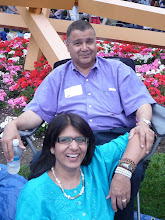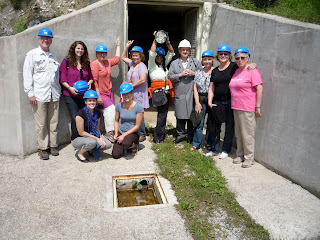With Macedonia in the throes of special elections for its parliament, it was a good weekend to find a place to vacation deep in Mavrovo National Forest on the western flank of the Republic. Not knowing what to expect, I was in for a surprise. The intensity of my experience during this vacation was not only a function of place alone, but also a combination of place, ambience and companionship. This weekend these three things came together.
Beyond the stunning vistas and the equally interesting monasteries with their relics – bone fragments of saints, a small piece of the cross Jesus was crucified on, etc., obtained at the time of the Holy Crusades in the 11th century - the utterly delightful experience of seeing how the villagers themselves appreciated their simple, slow pace of life, the unpolluted air and the nutritious nourishing food growing abundantly around there homes set the stage.
Of the two must see monasteries in the area, the outbuildings of Sveti Jovan Bigorski, most well known off all in Macedonia, had burned down two years ago in 2009 and were under construction during this visit. This monastery is nestled in a peaceful tranquil setting on the western flank of the Bistra mountain range. Hidden in the forest, it is reminiscent of the time when the world was in flames with the battles between the Roman Empire and the crusaders. Fortunately, the stone church built in 1020 AD and dedicated to St John the Baptist, and the main wooden monastery buildings were saved in this fire. These buildings have the look and feel of newness as they have been remodeled and added along, especially in the early 19th century, a fairly recent event in its history. The soffits are built in the same style as the Turkish sultan’s palaces in Istanbul as was the room where we had coffee.
On the other hand, the women only Rajcica monastery with the church of Sv. Gjorgi, offering a stunning vista of Debar Lake was perched on the most visible location by the lake! The day we visited was sunny, bright with blue skies and the terraced monastery grounds filled with a profusion of red roses and green grass. It was stunningly beautiful. Inside, the dining hall tables were covered with drying mint leaves, to be later added to bottles of oil, liquor and sugar water for mint flavored products.
We had a tour of a gypsum mine by a Macedonian engineer from the German plasterboard construction company Knauf. Though he was very thorough, the tour was in Macedonian language and it was hard to believe that this large valuable pure gypsum mine was handed it over to the German company without any payment. This encompasses a known area of approximately 10 km long by 1 ½ km wide by 700 meters high and sits along the northeastern edge of Debar Lake. Depth unknown. So I did a little web research. According to Wikipedia, inexpensive Gypsum (known as gips in Macedonia) is a calcium sulfite mineral with the formula CaSO4·2H2O and though used primarily for drywall, it's uses vary from fertilizer, dietary calcium, flash freezing cement and plaster of Paris among others! I wonder what they add for calcium-fortified milk etc. in the US!
 Our host, a hotelier with the Slow Food vision, something quite unusual in this part of the Balkan peninsula provided the vital ingredients that changed a ho hum holiday to this incredible experience. Slow Food is a non-profit member-supported association, founded in 1989 by Carlo Petrini in Italy, to counter the rise of fast food and fast life, the disappearance of local food traditions and people’s dwindling interest in the food they eat, where it comes from, how it tastes and how our food choices affect the rest of the world.
Our host, a hotelier with the Slow Food vision, something quite unusual in this part of the Balkan peninsula provided the vital ingredients that changed a ho hum holiday to this incredible experience. Slow Food is a non-profit member-supported association, founded in 1989 by Carlo Petrini in Italy, to counter the rise of fast food and fast life, the disappearance of local food traditions and people’s dwindling interest in the food they eat, where it comes from, how it tastes and how our food choices affect the rest of the world.On arrival at Hotel Tutto, after we oohed and aahed our way in, we were seated at one of the tables on the terrace with stunning views of the River Radika. We started with a very traditional yellow rakia, a Macedonian plum brandy. As we waited for the salad, we became quite a raucous group, drinking alcohol albeit a little, on an empty stomach. The food came in different courses and with simple recipes using local vegetables and dairy products. The meats – veal, chicken and fish were delicately flavored. After the main course and before dessert, we walked through the village picking the herbs – mint, chamomile, thyme, oregano, etc as we walked along – our host thoughtfully provided us with plastic bags! Dessert of baklava and ice cream with coffee came after our return about two hours later! No dinner necessary. Breakfast was an equally superb gastronomic experience, where we consumed fresh preserves of strawberry and apricot jams with our buttered toast, omelet, white cheese, both sun-dried and freshly sliced tomatoes, roasted banana peppers, olives, slices of baloney (?) and fresh air. Truly a wonderful weekend vacation!










No comments:
Post a Comment